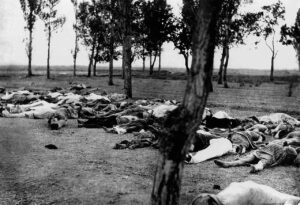
Genocide is defined as “the deliberate and systematic extermination of a national, racial, political, or cultural group.” It is a serious crime against humanity in which one group of people considers another group to be worthy of complete destruction based on their race, political beliefs, or religion. The act of genocide is not complete until every person of any age from the opposing culture has been killed.
There are eight separate stages of genocide. It begins with classification, or defining a group that is considered to be an enemy. Next is symbolization, in which a logo is used as a symbol of the hatred one group feels towards another. The third step, dehumanization, involves any efforts to make an enemy appear to be less than human in appearance or intelligence. Organization is the fourth stage, and it is the process of putting together a military force that can be used against the enemy faction. When the combative group spews forth propaganda that is designed to induce fear of or hatred towards a declared enemy, it is known as polarization, the fifth stage of genocide. Sixth is preparation – readying an army to do battle against another group of people. The seventh stage is the actual act of genocide, which involves the destruction of a declared enemy. This stage is referred to as extermination because it does not end until the opposing group is entirely wiped out. The eighth and final stage of genocide is known as denial. This occurs when the people who have participated in an act of genocide refuse to admit to the despicable criminal acts they have carried out.
The United Nations strictly prohibits any act of genocide and has held the Convention on the Prevention and Punishment of the Crime of Genocide (CPPCG) to define and criminalize the act. It is an abominable war crime that is punishable by the International Criminal Court.
